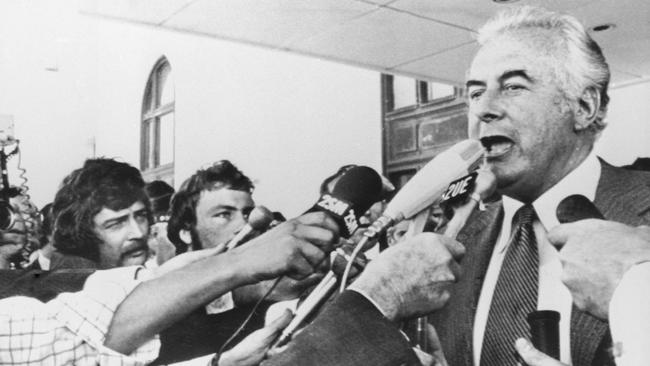
While the Whitlam government was often an administrative shambles, marked by poor public service relations, ill-disciplined ministers, a dysfunctional cabinet and disruptive caucus, and its economic management was disastrous, it still managed to leave a towering record of achievement.
It is instructive to look back at the ill-fated Labor government of 1972 to 1975 because when compared with recent Coalition and Labor governments, the Whitlam government accomplished vastly more across a shorter period. In fact, the Whitlam legacy looks only better and better when compared with recent governments.
It is why the Institute of Public Affairs – which played a foundational role in the Liberal Party – urged Tony Abbott in a 2012 paper to “Be Like Gough” if he wanted to “secure his place in history”. Why? Because, as John Roskam, Chris Berg and James Paterson argued, “no prime minister changed Australia more”.
In three tumultuous years, the Whitlam government introduced universal healthcare; shifted the funding of schools to a needs-based model; established a new honours system; inaugurated a new national anthem; supported the arts with new programs; initiated FM radio and Double J; required environmental impact statements for major cabinet decisions; and sewered the suburbs.
The legal reforms include removing the final vestiges of the White Australia policy from immigration regulations; abolishing the death penalty; lowering the voting age to 18; electing territory senators; Aboriginal land rights (passed during the Fraser government); introducing no-fault divorce, legal aid, one-vote one-value electoral laws, anti-discrimination and equal opportunity measures; and abolishing legal appeals to the British Privy Council.
Foreign policy was reoriented to focus on the Asia-Pacific and included diplomatic recognition of China – opposed by the Coalition – and encouraging Papua New Guinea to independence. The final withdrawal of Australian forces from Vietnam, the abolition of conscription and the freeing of conscientious objectors from jail were early decisions.
Yet Whitlam’s criticisms of Richard Nixon’s 1972 Christmas bombing in North Vietnam plunged Australia-US relations to their lowest point. There were discussions within the Nixon administration about the future of the alliance and intelligence sharing. However, the US understood the change in Australia’s international outlook and viewed Whitlam as among the more moderate of ministers, and relations improved.
The Whitlam government’s economic management was often ruinous. It cycled through three treasurers – Frank Crean, Jim Cairns and Bill Hayden – and gained coherence only with Hayden’s 1975 budget, which restored a degree of credibility in the government’s final months. While the economy was in a downturn when it came to office and endured a series of external shocks, the drive to implement its agenda made inflation and unemployment worse as growth slowed.
In the rush to fund new programs, government spending rose by 46 per cent in 1974-75. Today the Treasury records the Whitlam government delivering two budget surpluses and one budget deficit. The Rudd, Gillard, Abbott, Turnbull and Morrison governments did not deliver a budget surplus. Moreover, they each produced a larger budget deficit as a proportion of GDP than Whitlam’s final budget.
The failure to deal with a wages explosion, caused by generous public sector wage increases and catch-up claims by unions in the private sector, was damaging. Yet the Whitlam government also invested in infrastructure, education and training, and childcare, which helped boost future productivity. It abolished tariffs and subsidies, and ended preferential tax treatment for some industries. It tackled anti-competitive behaviour with new trade practices laws.
Many of these achievements were because of Whitlam, the self-described “crash through or crash” politician, who was determined to turn Australia in a new direction. He saw governing not as a permission to preside, he said, but as a command to perform. He had a large presence, was hugely intelligent and inspired devotion. He was witty and erudite, a brilliant orator and superb debater, with a devilish sense of humour.
Whitlam was a change agent who also changed the prime ministership. It became an office of activism as power and authority became more centralised. Whitlam was the dominant personality in his government, standing head and shoulders (literally and figuratively) above other ministers. He understood that politics is essentially the art of leadership, and that remains a principal legacy.
But before he could reform the nation, he had to reform the Labor Party. He succeeded in changing the party’s archaic structure, policies, campaigning and culture. He made it into a modern party capable of winning elections. And this is where Whitlam also stands apart from recent prime ministers because he won two elections in a row. No PM has done that since John Howard a generation ago.
The flip side of this policy and political success was the chaotic method of governing. Cabinet meetings were rowdy, caucus was often in revolt and several ministers were caught in scandals. The relationship with the public service was marked by suspicion. The government often seemed blind to public opinion. These vital lessons were learnt by Hayden, Bob Hawke and Paul Keating.
For many, the Whitlam government was too much razzle and dazzle, and the pace of change was unsettling. But for others it was thrilling and exciting, with the hope and promise that Australia’s full potential was finally being realised at the dawn of a new age. The fact this new direction was followed by Whitlam’s successors and his policies, once strongly opposed, became bipartisan articles of faith is fitting vindication.




The election of Gough Whitlam’s government 50 years ago this week serves as a reminder of the power of politics and leadership to fundamentally change a nation for the better. The policy changes implemented by the Whitlam government across so many areas were transformative and lasting.